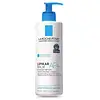What's inside
What's inside
 Key Ingredients
Key Ingredients

 Benefits
Benefits

 Concerns
Concerns

 Ingredients Side-by-side
Ingredients Side-by-side

Water
Skin ConditioningButyrospermum Parkii Butter
Skin ConditioningGlycerin
HumectantDimethicone
EmollientNiacinamide
SmoothingParaffinum Liquidum
EmollientCetearyl Alcohol
EmollientBrassica Napus Seed Oil
EmollientAmmonium Alum
AstringentAmmonium Polyacryloyldimethyl Taurate
Emulsion StabilisingPEG-100 Stearate
Glyceryl Stearate
EmollientPEG-20 Methyl Glucose Sesquistearate
EmulsifyingCera Microcristallina
Emulsion StabilisingParaffin
PerfumingSorbitan Tristearate
EmulsifyingDimethiconol
EmollientMannose
HumectantDisodium EDTA
Capryloyl Glycine
CleansingVitreoscilla Ferment
Skin ConditioningXanthan Gum
EmulsifyingPentaerythrityl Tetra-Di-T-Butyl Hydroxyhydrocinnamate
AntioxidantSodium Benzoate
MaskingWater, Butyrospermum Parkii Butter, Glycerin, Dimethicone, Niacinamide, Paraffinum Liquidum, Cetearyl Alcohol, Brassica Napus Seed Oil, Ammonium Alum, Ammonium Polyacryloyldimethyl Taurate, PEG-100 Stearate, Glyceryl Stearate, PEG-20 Methyl Glucose Sesquistearate, Cera Microcristallina, Paraffin, Sorbitan Tristearate, Dimethiconol, Mannose, Disodium EDTA, Capryloyl Glycine, Vitreoscilla Ferment, Xanthan Gum, Pentaerythrityl Tetra-Di-T-Butyl Hydroxyhydrocinnamate, Sodium Benzoate
Water
Skin ConditioningMethyl Glucose Sesquistearate
EmollientPhenyl Trimethicone
Skin ConditioningDodecane
PerfumingCaprylic/Capric Triglyceride
MaskingCetearyl Alcohol
EmollientParfum
MaskingGlycerin
HumectantCetyl Alcohol
EmollientGlyceryl Stearate Citrate
EmollientSodium Hyaluronate
HumectantCocos Nucifera Oil
MaskingEuterpe Oleracea Fruit Oil
Skin ConditioningTheobroma Grandiflorum Seed Butter
Skin ConditioningBertholletia Excelsa Seed Oil
EmollientPaullinia Cupana Seed Extract
Skin ConditioningIlex Guayusa Leaf Extract
Skin ProtectingIlex Paraguariensis Leaf Extract
PerfumingBixa Orellana Seed Extract
MaskingDaucus Carota Sativa Seed Oil
EmollientSqualane
EmollientTocopherol
AntioxidantSodium Phytate
Sodium Stearoyl Glutamate
CleansingGlyceryl Caprylate
EmollientEthylhexylglycerin
Skin ConditioningXanthan Gum
EmulsifyingHydroxyethyl Acrylate/Sodium Acryloyldimethyl Taurate Copolymer
Emulsion StabilisingSorbitan Isostearate
EmulsifyingPhenoxyethanol
PreservativeMica
Cosmetic ColorantBenzyl Alcohol
PerfumingBenzyl Benzoate
AntimicrobialBenzyl Salicylate
PerfumingCitral
PerfumingCoumarin
PerfumingEugenol
PerfumingButylphenyl Methylpropional
PerfumingLimonene
PerfumingLinalool
PerfumingWater, Methyl Glucose Sesquistearate, Phenyl Trimethicone, Dodecane, Caprylic/Capric Triglyceride, Cetearyl Alcohol, Parfum, Glycerin, Cetyl Alcohol, Glyceryl Stearate Citrate, Sodium Hyaluronate, Cocos Nucifera Oil, Euterpe Oleracea Fruit Oil, Theobroma Grandiflorum Seed Butter, Bertholletia Excelsa Seed Oil, Paullinia Cupana Seed Extract, Ilex Guayusa Leaf Extract, Ilex Paraguariensis Leaf Extract, Bixa Orellana Seed Extract, Daucus Carota Sativa Seed Oil, Squalane, Tocopherol, Sodium Phytate, Sodium Stearoyl Glutamate, Glyceryl Caprylate, Ethylhexylglycerin, Xanthan Gum, Hydroxyethyl Acrylate/Sodium Acryloyldimethyl Taurate Copolymer, Sorbitan Isostearate, Phenoxyethanol, Mica, Benzyl Alcohol, Benzyl Benzoate, Benzyl Salicylate, Citral, Coumarin, Eugenol, Butylphenyl Methylpropional, Limonene, Linalool
 Reviews
Reviews

Ingredients Explained
These ingredients are found in both products.
Ingredients higher up in an ingredient list are typically present in a larger amount.
Cetearyl alcohol is a mixture of two fatty alcohols: cetyl alcohol and stearyl alcohol. It is mainly used as an emulsifier. Emulsifiers help prevent the separation of oils and products. Due to its composition, it can also be used to thicken a product or help create foam.
Cetearyl alcohol is an emollient. Emollients help soothe and hydrate the skin by trapping moisture.
Studies show Cetearyl alcohol is non-toxic and non-irritating. The FDA allows products labeled "alcohol-free" to have fatty alcohols.
This ingredient is usually derived from plant oils such as palm, vegetable, or coconut oils. There is debate on whether this ingredient will cause acne.
Due to the fatty acid base, this ingredient may not be Malassezia folliculitis safe.
Learn more about Cetearyl AlcoholGlycerin is already naturally found in your skin. It helps moisturize and protect your skin.
A study from 2016 found glycerin to be more effective as a humectant than AHAs and hyaluronic acid.
As a humectant, it helps the skin stay hydrated by pulling moisture to your skin. The low molecular weight of glycerin allows it to pull moisture into the deeper layers of your skin.
Hydrated skin improves your skin barrier; Your skin barrier helps protect against irritants and bacteria.
Glycerin has also been found to have antimicrobial and antiviral properties. Due to these properties, glycerin is often used in wound and burn treatments.
In cosmetics, glycerin is usually derived from plants such as soybean or palm. However, it can also be sourced from animals, such as tallow or animal fat.
This ingredient is organic, colorless, odorless, and non-toxic.
Glycerin is the name for this ingredient in American English. British English uses Glycerol/Glycerine.
Learn more about GlycerinWater. It's the most common cosmetic ingredient of all. You'll usually see it at the top of ingredient lists, meaning that it makes up the largest part of the product.
So why is it so popular? Water most often acts as a solvent - this means that it helps dissolve other ingredients into the formulation.
You'll also recognize water as that liquid we all need to stay alive. If you see this, drink a glass of water. Stay hydrated!
Learn more about WaterXanthan gum is used as a stabilizer and thickener within cosmetic products. It helps give products a sticky, thick feeling - preventing them from being too runny.
On the technical side of things, xanthan gum is a polysaccharide - a combination consisting of multiple sugar molecules bonded together.
Xanthan gum is a pretty common and great ingredient. It is a natural, non-toxic, non-irritating ingredient that is also commonly used in food products.
Learn more about Xanthan Gum